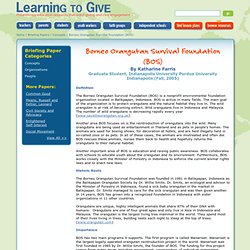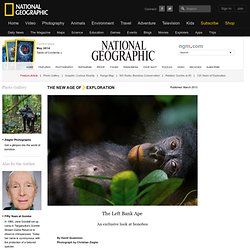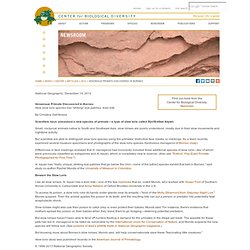

Borneo Orangutan Survival Foundation (BOS) (Informational Paper) Graduate Student, Indianapolis University Purdue University Indianapolis (Fall, 2005) Definition The Borneo Orangutan Survival Foundation (BOS) is a nonprofit environmental foundation organization located in Balikpapan, Indonesia.

BOS is active in many fields. The main goal of the organization is to protect orangutans and the natural habitat they live in. The wild orangutan is at risk of becoming extinct. Another area BOS focuses on is the reintroduction of orangutans into the wild. Another important area of BOS is education and raising public awareness. Historic Roots The Borneo Orangutan Survival Foundation was founded in 1991 in Balikpapan, Indonesia as the Balikpapan Orangutan Society by Dr. Orangutans are unique, highly intelligent animals that share 97% of their DNA with humans. Importance BOS has two main programs it supports. The second program is called Nyaru Menteng. Ties to the Philanthropic Sector Key Related Ideas Ape Smuggling has become a big problem in Thailand. Wild Futures Shop. Adopt a monkey and protect primates worldwide.

Deforestation and the bush meat trade threaten primate species worldwide, leading to forty three species now considered to be Critically Endangered. The primate pet trade is also a huge problem causing suffering and neglect, with about 5,000 privately owned primates in the UK alone. Help our charity, Wild Futures, protect primates in the UK and abroad by adopting a monkey today. How you are helping primates: Enabling our UK Sanctuary care for monkeys rescued from the pet trade and entertainment industryCampaigning to end the primate pet trade in the UK and abroadEducating more than 30,000 people a year on primate welfare, conservation and sustainable livingSupporting conservation projects overseas linked to primate welfare and habitat conservation.
In return, we will send you: How your adoption can help: By adopting a monkey today you will be helping to make a difference to primates worldwide. Thank you and welcome! Mother's Day. The Wild Life of a Bonobo. In a remote forest sector of the Democratic Republic of the Congo, along the north bank of the Luo River, 50 miles by dirt trail from the nearest grass airstrip, lies the Wamba research camp, a place that’s quietly renowned in the annals of primatology.

Wamba was founded in 1974 by a Japanese primatologist named Takayoshi Kano for the study of the bonobo, Pan paniscus, a species of simian unlike any other. The bonobo, in case you haven’t heard, carries a reputation as the “make love, not war” member of the ape lineage, far lustier and less bellicose than its close cousin, the chimpanzee. Modern studies of zoo populations by the Dutch-American biologist Frans de Waal and others have documented its easy, pervasive sexuality and its propensity for amicable bonding (especially among females), in contrast with chimpanzee dominance battles (especially among males) and intergroup warfare. “Hunting behavior—it’s very rare,” said Sakamaki. “So you are very lucky.” "Extinct," Pop-Eyed Primate Photographed for First Time. Long thought to be extinct, one of the world's rarest primates has been caught on camera for the first time, scientists announced Monday. (Related: "'Extinct' Bird Seen, Eaten. ") Discovered in 1937 but "missing" for 60 years, Sri Lanka's Horton Plains slender loris was presumed to have died out.
In 2002 a fleeting nighttime sighting of something looking like the elusive tree-dweller, however, gave conservationists hope. Follow-up surveys led by the Zoological Society of London finally confirmed the lorises are alive—if not exactly well—in 2009, when two individuals were photographed and examined. Initial estimates after the rediscovery put the total world population at fewer than a hundred, said the society's conservation biologist Craig Turner. "Potentially this is the rarest primate we're aware of today," Turner said.
(Related pictures: "25 most endangered primates named. ") Lonely Lorises "There's no means for these lorises to move between the [remaining] forest patches," Turner said. Venomous Primate Discovered in Borneo. National Geographic, December 14, 2012 Venomous Primate Discovered in Borneo New slow loris species has "striking" eye patches, toxic bite.

By Christine Dell'Amore Scientists have unmasked a new species of primate—a type of slow loris called Nycticebus kayan. Small, nocturnal animals native to South and Southeast Asia, slow lorises are poorly understood, mostly due to their slow movements and nighttime activity. But scientists are able to distinguish slow loris species using the primates' distinctive face masks, or markings.
Differences in face markings revealed that N. menagenis had incorrectly included three additional species of slow loris—two of which were previously classified as subspecies and N. kayan, which is completely new to science. N. kayan has "really unique, striking eye patches that go below the chin—none of the [other] species exhibit that trait in Borneo," said study co-author Rachel Munds of the University of Missouri in Columbia.
Wild Futures.